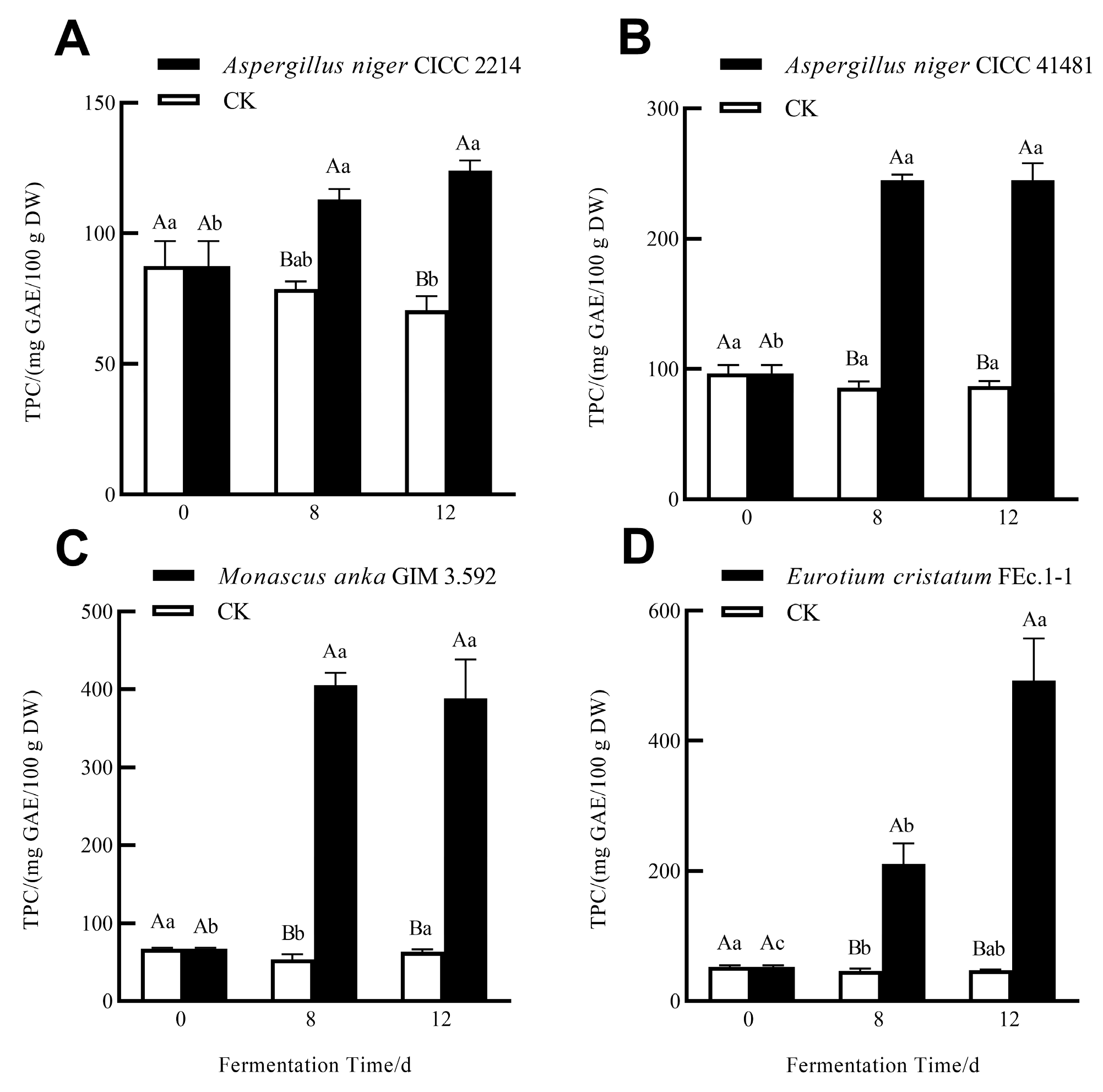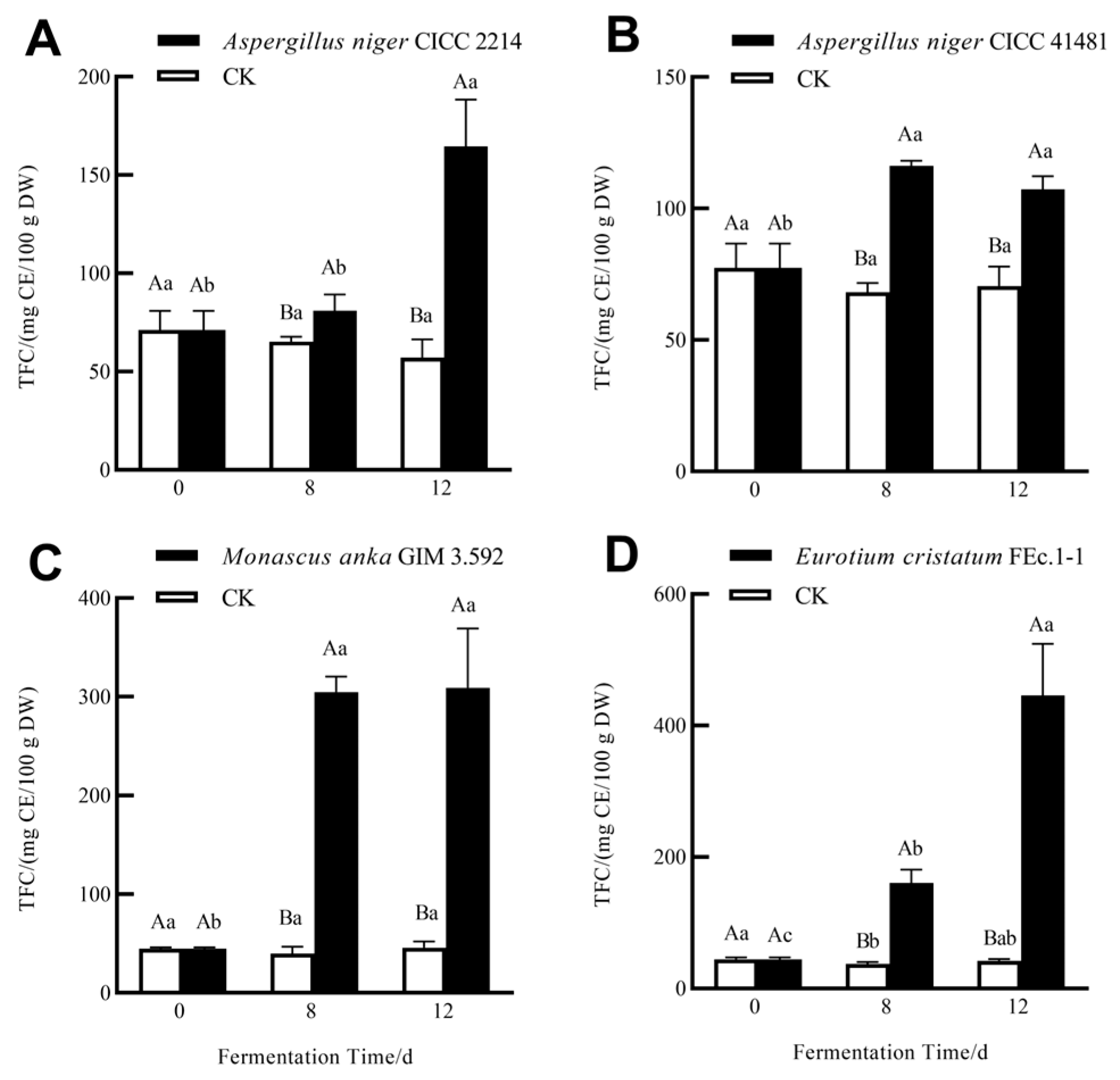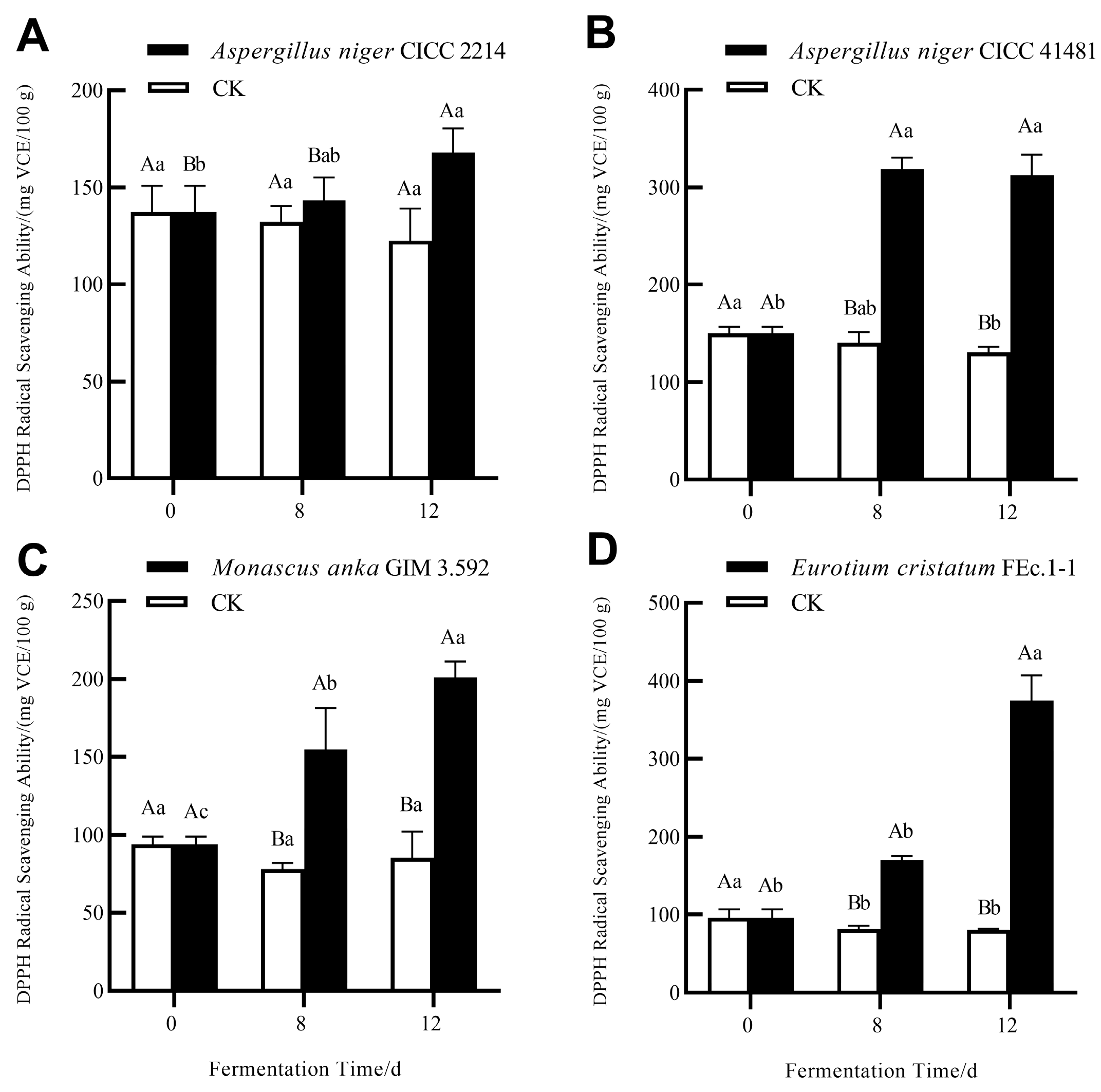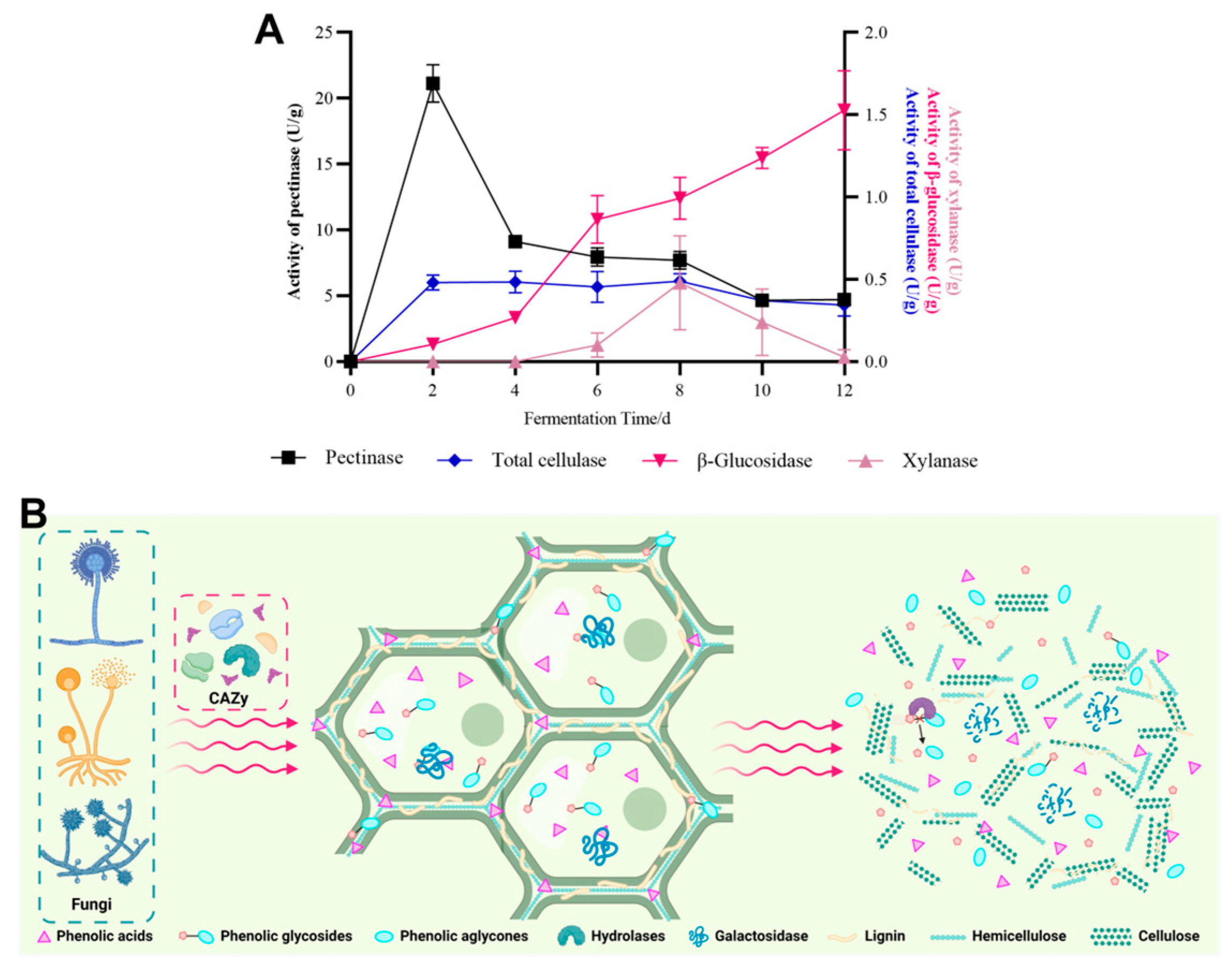Improving Soluble Phenolic Profile and Antioxidant Activity of Grape Pomace Seeds through Fungal Solid-State Fermentation
Abstract
:1. Introduction
2. Materials and Methods
2.1. Sample Pretreatment
2.2. Bacterial Strains, Media, and Culture Conditions
2.3. SSF
2.4. Extraction of Soluble and Insoluble Phenolics
2.5. Determination of Total Phenolic and Total Flavonoid Content
2.6. Phenolic Composition Analysis
2.7. DPPH and ABTS Radical Scavenging Capacities
2.8. Extraction of Crude Enzyme from Solid-State Fermentation Samples
2.9. Determination of Hydrolase Activities during SSF
2.10. Statistical Analysis
3. Results and Discussion
3.1. Enchaned Release of Soluble Phenolics of Grape Pomace Seeds via SSF with Different Fungi
3.1.1. TPC and TFC
3.1.2. Individual Phenolics
3.2. Enhanced Antioxidant Activity of Soluble Phenolics of Grape Pomace Seeds via SSF with Different Fungi
3.3. Dynamic Changes in Soluble Phenolics, Insoluble Phenolics, and Antioxidant Activities of Grape Pomace Seeds during SSF with M. anka
3.4. Dynamic Changes in Hydrolase Activities during SSF with M. anka
4. Conclusions
Author Contributions
Funding
Institutional Review Board Statement
Informed Consent Statement
Data Availability Statement
Conflicts of Interest
References
- Beres, C.; Costa, G.N.S.; Cabezudo, I.; Silva-James, N.K.; Teles, A.S.C.; Cruz, A.P.G.; Mellinger-Silva, C.; Tonon, R.V.; Cabral, L.M.C.; Freitas, S.P. Towards integral utilization of grape pomace from winemaking process: A review. Waste Manag. 2017, 68, 581–594. [Google Scholar] [CrossRef] [PubMed]
- Georgiev, V.; Ananga, A.; Tsolova, V. Recent advances and uses of grape flavonoids as nutraceuticals. Nutrients 2014, 6, 391–415. [Google Scholar] [CrossRef] [PubMed]
- Dinicola, S.; Cucina, A.; Pasqualato, A.; D’Anselmi, F.; Proietti, S.; Lisi, E.; Pasqua, G.; Antonacci, D.; Bizzarri, M. Antiproliferative and apoptotic effects triggered by grape seed extract (GSE) versus epigallocatechin and procyanidins on colon cancer cell lines. Int. J. Mol. Sci. 2012, 13, 651–664. [Google Scholar] [CrossRef] [PubMed]
- Prasad, R.; Katiyar, S.K. Grape seed proanthocyanidins inhibit migration potential of pancreatic cancer cells by promoting mesenchymal-to-epithelial transition and targeting NF-kappa B. Cancer Lett. 2013, 334, 118–126. [Google Scholar] [CrossRef] [PubMed]
- Derry, M.M.; Raina, K.; Agarwal, R.; Rajesh, A.; Agarwal, C. Characterization of azoxymethane-induced colon tumor metastasis to lung in a mouse model relevant to human sporadic colorectal cancer and evaluation of grape seed extract efficacy. Exp. Toxicol. Pathol. 2014, 66, 235–242. [Google Scholar] [CrossRef] [PubMed]
- Silván, J.M.; Mingo, E.; Hidalgo, M.; Pascual-Teresa, S.; Carrascosa, A.V.; Martinez-Rodriguez, A.J. Antibacterial activity of a grape seed extract and its fractions against Campylobacter spp. Food Control 2013, 29, 25–31. [Google Scholar] [CrossRef]
- Kadri, S.; Ayed, M.E.; Kadri, A.; Limam, F.; Aouani, E.; Mokni, M. Protective effect of grape seed extract and orlistat co-treatment against stroke: Effect on oxidative stress and energy failure. Biomed. Pharmacother. 2021, 136, 111282. [Google Scholar] [CrossRef]
- Camargo, A.C.; Regitano-d’Arce, M.A.B.; Biasoto, A.C.T.; Shahidi, F. Enzyme-assisted extraction of phenolics from winemaking by-products: Antioxidant potential and inhibition of alpha-glucosidase and lipase activities. Food Chem. 2016, 212, 395–402. [Google Scholar] [CrossRef] [PubMed]
- Hellstrom, J.K.; Mattila, P.H. HPLC determination of extractable and unextractable proanthocyanidins in plant materials. J. Agric. Food Chem. 2008, 56, 7617–7624. [Google Scholar] [CrossRef]
- Acosta-Estrada, B.A.; Gutiérrez-Uribe, J.A.; Sergio, O. Serna-Saldívar. Bound phenolics in foods, a review. Food Chem. 2014, 152, 46–55. [Google Scholar] [CrossRef]
- Sani, I.M.; Iqbal, S.; Chan, K.W.; Ismail, M. Effect of acid and base catalyzed hydrolysis on the yield of phenolics and antioxidant activity of extracts from germinated brown rice (GBR). Molecules 2012, 17, 7584–7594. [Google Scholar] [CrossRef] [PubMed]
- White, B.L.; Howard, L.R.; Prior, R.L. Release of bound procyanidins from cranberry pomace by alkaline hydrolysis. J. Agric. Food. Chem. 2010, 58, 7572–7579. [Google Scholar] [CrossRef] [PubMed]
- Yafetto, L. Application of solid-state fermentation by microbial biotechnology for bioprocessing of agro-industrial wastes from 1970 to 2020: A review and bibliometric analysis. Heliyon 2022, 8, 3. [Google Scholar] [CrossRef] [PubMed]
- Kumar, V.; Ahluwalia, V.; Saran, S.; Kumar, J.; Patel, A.K.; Singhania, R.R. Recent developments on solid-state fermentation for production of microbial secondary metabolites: Challenges and solutions. Bioresour. Technol. 2021, 323, 124566. [Google Scholar] [CrossRef] [PubMed]
- Bei, Q.; Chen, G.; Lu, F.; Wu, S.; Wu, Z. Enzymatic action mechanism of phenolic mobilization in oats (Avena sativa L.) during solid-state fermentation with Monascus anka. Food Chem. 2018, 245, 297–304. [Google Scholar] [CrossRef]
- María-Rocío, M.; Ignacio, C.; Cecilia, S.G.; Diana, R. Production of grape pomace extracts with enhanced antioxidant and prebiotic activities through solid-state fermentation by Aspergillus niger and Aspergillus oryzae. Food Biosci. 2021, 42, 101168. [Google Scholar]
- Wang, L.; Lin, X.; Zhang, J.C.; Zhang, W.M.; Hu, X.P.; Li, W.; Li, C.F.; Liu, S.X. Extraction methods for the releasing of bound phenolics from Rubus idaeus L. leaves and seeds. Ind. Crop. Prod. 2019, 135, 1–9. [Google Scholar] [CrossRef]
- Tournour, H.H.; Segundo, M.A.; Magalhães, L.M.; Barreiros, L.; Queiroz, J.; Cunha, L.M. Valorization of grape pomace: Extraction of bioactive phenolics with antioxidant properties. Ind. Crop. Prod. 2015, 74, 397–406. [Google Scholar] [CrossRef]
- Muller, L.; Fröhlich, K.; Böhm, V. Comparative antioxidant activities of carotenoids measured by ferric reducing antioxidant power (FRAP), ABTS bleaching assay (αTEAC), DPPH assay and peroxyl radical scavenging assay. Food Chem. 2011, 129, 139–148. [Google Scholar] [CrossRef]
- Teles, A.S.C.; Chávez, D.W.H.; Oliveira, R.A.; Bon, E.P.S.; Terzi, S.C.; Souza, E.F.; Gottschalk, L.M.F.; Tonon, R.V. Use of grape pomace for the production of hydrolytic enzymes by solid-state fermentation and recovery of its bioactive compounds. Int. Food Res. J. 2019, 120, 441–448. [Google Scholar] [CrossRef]
- Teles, A.S.C.; Chávez, D.W.H.; Santiago, M.C.P.A.; Gottschalk, L.M.F.; Tonon, R.V. Composition of different media for enzyme production and its effect on the recovery of phenolic compounds from grape pomace. Biocatal 2021, 35, 102067. [Google Scholar] [CrossRef]
- Huang, C.H.; Tao, J.J.; Liao, G.L.; Xie, M.; Qu, X.Y.; Chen, L.; Xu, X.B. Dynamic changes of phenol and antioxidant capacity during fruit development of three Actinidia species (kiwifruit). Sci. Hortic. 2020, 273, 109571. [Google Scholar] [CrossRef]
- Forman, H.J.; Zhang, H. Targeting oxidative stress in disease: Promise and limitations of antioxidant therapy. Nat. Rev. Drug Discov. 2021, 20, 689–709. [Google Scholar] [CrossRef] [PubMed]
- Tungmunnithum, D.; Thongboonyou, A.; Pholboon, A.; Yangsabai, A. Flavonoids and other phenolic compounds from medicinal plants for pharmaceutical and medical aspects: An Overview. Medicines 2018, 5, 93. [Google Scholar] [CrossRef] [PubMed]
- Gulcin, İ. Antioxidants and antioxidant methods: An updated overview. Arch. Toxicol. 2020, 94, 651–715. [Google Scholar] [CrossRef] [PubMed]
- Wang, L.; Wei, W.; Tian, X.; Shi, K.; Wu, Z. Improving bioactivities of polyphenol extracts from Psidium guajava L. leaves through co-fermentation of Monascus anka GIM 3.592 and Saccharomyces cerevisiae GIM 2.139. Ind. Crop. Prod. 2016, 94, 206–215. [Google Scholar]
- Fuchs, G.; Boll, M.; Heider, J. Microbial degradation of aromatic compounds–From one strategy to four. Nat. Rev. Microbiol. 2011, 9, 803–816. [Google Scholar] [CrossRef] [PubMed]
- Lubbers, R.J.M.; Dilokpimol, A.; Visser, J.; Mäkelä, M.R.; Hildén, K.S.; Vries, R.P. A comparison between the homocyclic aromatic metabolic pathways from plant-derived compounds by bacteria and fungi. Biotechnol. Adv. 2019, 37, 107396. [Google Scholar] [CrossRef] [PubMed]
- Feng, S.Y.; Zhang, Y.H.; Fu, S.D.; Li, Z.; Zhang, J.Q.; Xu, Y.Y.; Han, X.G.; Miao, J.F. Application of Chlorogenic acid as a substitute for antibiotics in Multidrug-resistant Escherichia coli-induced mastitis. Int. Immunopharmacol. 2023, 114, 109536. [Google Scholar] [CrossRef]
- Dulf, F.V.; Vodnar, D.C.; Tosa, M.I.; Dulf, E.H. Simultaneous enrichment of grape pomace with γ-linolenic acid and carotenoids by solid-state fermentation with Zygomycetes fungi and antioxidant potential of the bioprocessed substrates. Food Chem. 2020, 310, 125921–125927. [Google Scholar] [CrossRef]
- Dall’Acqua, S.; Kumar, G.; Sinan, K.I.; Sut, S.; Ferrarese, I.; Mahomoodally, M.F.; Seebaluck-Sandoram, R.; Etienne, O.K.; Zengin, G. An insight into Cochlospertnum planchonii extracts obtained by traditional and green extraction methods: Relation between chemical compositions and biological properties by multivariate analysis. Ind. Crop. Prod. 2020, 147, 112226. [Google Scholar] [CrossRef]
- Dey, T.B.; Kuhad, R.C. Upgrading the antioxidant potential of cereals by their fungal fermentation under solid-state cultivation conditions. Lett. Appl. Microbiol. 2014, 59, 493–499. [Google Scholar]
- Unusan, N. Proanthocyanidins in grape seeds: An updated review of their health benefits and potential uses in the food industry. J. Funct. Foods 2020, 67, 1756–4646. [Google Scholar] [CrossRef]
- Wang, L.; Zhang, J.C.; Zhang, W.M.; Lin, X.; Li, C.F.; Wu, Z.Q. Role of carbohydrate-cleaving enzymes in phenolic mobilization of guava leaves tea during solid state bio-processing with Monascus anka and Bacillus sp. Process Biochem. 2019, 82, 51–58. [Google Scholar] [CrossRef]
- Bei, Q.; Liu, Y.; Wang, L.; Chen, G.; Wu, Z.Q. Improving free, conjugated, and bound phenolic fractions in fermented oats (Avena sativa L.) with Monascus anka and their antioxidant activity. J. Funct. Foods 2017, 32, 185–194. [Google Scholar] [CrossRef]
- Cai, S.B.; Wang, O.; Wu, W.; Zhu, S.J.; Zhou, F.; Ji, B.P.; Gao, F.Y.; Zhang, D.; Liu, J.; Cheng, Q. Comparative study of the effects of solid-state fermentation with three filamentous fungi on the total phenolics content (TPC), flavonoids, and antioxidant activities of subfractions from oats (Avena sativa L.). J. Agric. Food Chem. 2012, 60, 507–513. [Google Scholar] [CrossRef] [PubMed]
- Bei, Q.; Chen, G.; Liu, Y.; Zhang, Y.; Wu, Z.Q. Improving phenolic compositions and bioactivity of oats by enzymatic hydrolysis and microbial fermentation. J. Funct. Foods 2018, 47, 512–520. [Google Scholar] [CrossRef]
- Roasa, J.; Villa, R.; Mine, Y.; Tsao, R. Phenolics of cereal, pulse and oilseed processing by-products and potential effects of solid-state fermentation on their bioaccessibility, bioavailability and health benefits: A review. Trends Food Sci. Tech. 2021, 116, 954–974. [Google Scholar] [CrossRef]
- Wan, F.; Feng, C.; Luo, K.; Cui, W.; Xia, Z.; Cheng, A. Effect of steam explosion on phenolics and antioxidant activity in plants: A review. Trends Food Sci. Tech. 2022, 124, 13–24. [Google Scholar] [CrossRef]






| Individual Phenolics | A. niger CICC 2214 CK | A. niger CICC 2214 | A. niger CICC 41481 CK | A. niger CICC 41481 | M. anka GIM3.592 CK | M. anka GIM3.592 | E. cristatum FEc.1-1 CK | E. cristatum FEc.1-1 |
|---|---|---|---|---|---|---|---|---|
| Gallic acid | 27.25 ± 0.70 A | ND | 37.36 ± 5.25 A | ND | 17.77 ± 0.36 A | ND | 15.28 ± 1.03 A | ND |
| Protocatechuic acid | 3.19 ± 0.03 A | ND | 4.91 ± 0.62 A | ND | 1.43 ± 0.03 A | 0.45 ± 0.09 B | 1.46 ± 0.23 A | ND |
| Procyanidins B1 | 0.70 ± 0.21 A | ND | 1.24 ± 0.37 A | 0.71 ± 0.26 B | 0.90 ± 0.03 B | 1.17 ± 0.07 A | 0.58 ± 0.08 B | 1.20 ± 0.37 A |
| Catechin | 18.00 ± 0.17 A | ND | 16.67 ± 3.51 A | ND | 14.09 ± 0.29 B | 34.52 ± 4.12 A | 10.86 ± 0.75 A | 1.91 ± 0.16 B |
| Chlorogenic acid | ND | 2.20 ± 0.18 A | ND | 11.12 ± 2.20 A | 0.18 ± 0.00 B | 80.56 ± 1.73 A | ND | 0.05 ± 0.00 A |
| Procyanidins B2 | 2.92 ± 0.19 A | ND | 3.88 ± 0.07 A | ND | 2.31 ± 0.00 A | 1.55 ± 0.5 A | 1.63 ± 0.20 A | 1.47 ± 0.10 A |
| Caffeic acid | ND | 2.47 ± 0.42 A | ND | 2.15 ± 0.26 A | ND | ND | ND | ND |
| Syringic acid | 0.67 ± 0.06 A | ND | 0.78 ± 0.17 A | ND | 0.35 ± 0.01 B | 2.85 ± 0.09 A | 0.53 ± 0.08 B | 3.36 ± 0.16 A |
| Epicatechin | 9.55 ± 0.36 B | * | 9.06 ± 1.18 B | * | 8.36 ± 0.78 A | 9.94 ± 0.48 A | 6.09 ± 0.60 A | 1.66 ± 0.16 B |
| Ferulic acid | ND | 0.74 ± 0.05 A | ND | 0.95 ± 0.04 A | ND | 6.15 ± 0.09 A | ND | 0.90 ± 0.15 A |
| Rutin | 4.61 ± 0.19 A | ND | 6.65 ± 1.34 A | 1.09 ± 0.02 B | 5.07 ± 1.19 A | 0.27 ± 0.03 B | 3.48 ± 0.85 B | 5.73 ± 0.09 A |
| Epicatechin gallate | ND | ND | ND | ND | ND | 2.59 ± 0.30 A | ND | 3.68 ± 0.73 A |
| Resveratrol | 0.01 ± 0.00 A | 0.08 ± 0.06 A | 0.09 ± 0.02 B | 0.30 ± 0.08 A | 0.01 ± 0.00 B | 0.14 ± 0.03 A | 0.03 ± 0.00 B | 0.11 ± 0.00 A |
Disclaimer/Publisher’s Note: The statements, opinions and data contained in all publications are solely those of the individual author(s) and contributor(s) and not of MDPI and/or the editor(s). MDPI and/or the editor(s) disclaim responsibility for any injury to people or property resulting from any ideas, methods, instructions or products referred to in the content. |
© 2024 by the authors. Licensee MDPI, Basel, Switzerland. This article is an open access article distributed under the terms and conditions of the Creative Commons Attribution (CC BY) license (https://creativecommons.org/licenses/by/4.0/).
Share and Cite
Zhao, Y.; Liu, D.; Zhang, J.; Shen, J.; Cao, J.; Gu, H.; Cui, M.; He, L.; Chen, G.; Liu, S.; et al. Improving Soluble Phenolic Profile and Antioxidant Activity of Grape Pomace Seeds through Fungal Solid-State Fermentation. Foods 2024, 13, 1158. https://doi.org/10.3390/foods13081158
Zhao Y, Liu D, Zhang J, Shen J, Cao J, Gu H, Cui M, He L, Chen G, Liu S, et al. Improving Soluble Phenolic Profile and Antioxidant Activity of Grape Pomace Seeds through Fungal Solid-State Fermentation. Foods. 2024; 13(8):1158. https://doi.org/10.3390/foods13081158
Chicago/Turabian StyleZhao, Yuzhu, Doudou Liu, Jiaxuan Zhang, Jiaxin Shen, Jiamin Cao, Huawei Gu, Mengqing Cui, Ling He, Gong Chen, Shuwen Liu, and et al. 2024. "Improving Soluble Phenolic Profile and Antioxidant Activity of Grape Pomace Seeds through Fungal Solid-State Fermentation" Foods 13, no. 8: 1158. https://doi.org/10.3390/foods13081158




